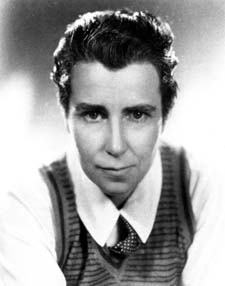Dorothy Arzner (Dorothy Arzner)

American Film Director. Her career in feature films spanned from the silent era of the late 1920s into the early 1940s. She was one of the very few women who established a name for herself as a director in the film industry during this time. Her body of work remains to this day the largest by a woman director within the studio system. Born in San Francisco, California, Arzner grew up in Los Angeles, where her father owned a restaurant frequented by many Hollywood celebrities. After finishing high school, she enrolled at the University of Southern California with hopes of becoming a doctor. During World War I, she left school to work overseas in the ambulance corps. By the time the war ended, she decided against returning to her medical studies and, after a visit to a movie studio, decided to pursue a career as a film director. Through connections with director William C. DeMille, Dorothy got a job at Paramount Pictures. She started out as a stenographer. She moved on to be a script writer, was promoted to film editor within six months and quickly mastered the job. Her first assignment as an editor was in 1922 for the renowned classic Blood and Sand, starring Rudolph Valentino. She was soon receiving accolades for the high quality of her work. Impressed by her technique, director James Cruze employed her as a writer and editor for several of his films, including Old Ironsides (1926). Arzner achieved a great deal of clout through this, along with her work on over fifty other films at Paramount. She eventually threatened to move to rival Columbia Studios unless given a directorial position. Paramount conceded in 1927, putting her in charge of the film Fashions for Women, which became a financial success. At Paramount, Arzner directed Clara Bow’s first talkie, The Wild Party. To allow Bow to move freely on the set, Arzner had technicians rig a microphone onto a fishing rod, essentially creating the first boom mike. The Wild Party was a success with critics and was the 3rd top-grossing film of 1929. The film, set in a women’s college, introduced some of the apparent lesbian undertones and themes often cited in Arzner’s work. According to film scholar Gwendolyn Audrey Foster, the film “carefully articulates what happens when women stray from the confines of the safe all-girl environment” when they are “subject to the sexist advances of drunk, aggressive men.” Her films of the following three years were strong examples of Hollywood before the Production Code. These films featured aggressive, free-spirited and independent women. She left Paramount in 1932 to begin work as an independent director for several of the studios. The films she directed during this period are her best known, launching the careers of many actresses, including Katharine Hepburn, Rosalind Russell, Sylvia Sidney and Lucille Ball. In 1936, Arzner became the first woman to join the newly formed Directors Guild of America. For reasons never fully disclosed, Arzner stopped directing feature-length films in 1943. She continued to work in the following years, directing television commercials and Army training films. She produced plays and, in the 1960s and 1970s, worked as a professor at the UCLA Film School, teaching screenwriting and directing until her death in 1979. One of her graduate students at UCLA was Francis Ford Coppola, who cited Arzner’s encouragement as pivotal to his film career. (bio courtesy of: Wikipedia) Family links: Parents: Ludwig Adolph Arzner (1867 – 1964) Jennette Young Leydier (1862 – 1909) Spouse: Marion Morgan (1881 – 1971)* Sibling: David Louis Arzner (1892 – 1916)* Dorothy Arzner (1897 – 1979) *Calculated relationship
Born
- January, 03, 1897
- USA
Died
- October, 10, 1979
- USA
Other
- Cremated

